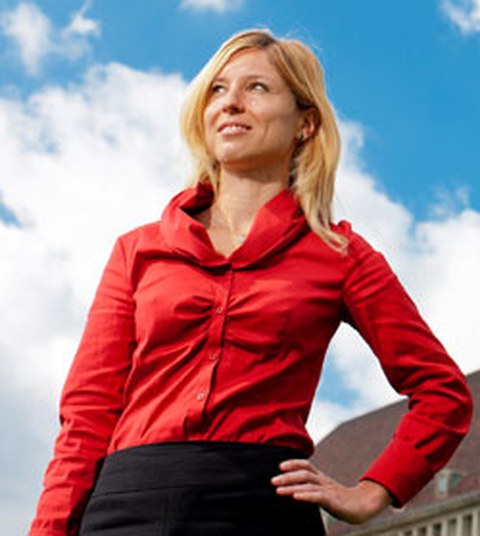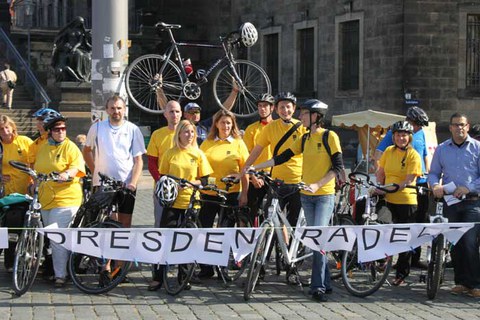A cycling all-rounder working for the climate
(Interview from 2012)
Dagmar Möbius
Spruce something up, preserve something beautiful, redefine it... Ina Helzig envisioned her future as a carpenter and furniture restorer shortly before graduating from high school. One thing was very clear: she wanted to live out her creativity and love of nature. "But I let myself be talked out of carpentry," laughs the 29-year-old.

Ina Helzig from Hainichen, Saxony, is head of the Dresden Climate Protection Office (Klimaschutzbüro).
Her goals remained to use, enhance, and alter what is already available. She started to think about a geography degree. After a fascinating UNI Live event at TU Dresden (TUD) complete with a lecture, she knew this was the subject for her. Ina Helzig started her degree in 2000. A geography major with minors in law, in urban, regional and state planning, plus landscaping and open space planning. Field trips and internships with planning agencies in the region ensured an exciting change from what could sometimes be a dry university routine. Ina Helzig wanted to become an urban planner but when she finished her degree in 2006, the job prospects looked bleak. The geography graduate decided instead to pursue postgraduate studies in environmental protection and regional development. Alongside her Diplom degree in science, she wanted to earn an engineering degree. Stay in Dresden was a not an insignificant factor, where she had a "large circle of friends."
During her postgraduate studies at TUD, she worked at a Berlin planning agency, for the Untere Naturschutzbehörde (Lower Nature Conservation Authority) in the district of Meißen, and as an urban planner at STEG Stadtentwicklung Dresden. "That was the fulfilment of my career aspirations," she says. At the same time, she discovered a new field: climate protection in municipalities. And there was more. When Dresden advertised for "a Climate Protection Office director," Ina Helzig applied. That has now been her role since October 2010. She completed her dissertation for her second degree after taking up her new post. The dissertation topic? Energy and climate protection in Saxon municipalities, including framework, instruments, and application. Specifically, she examined how energy-saving potential could be tapped, how a sustainable energy supply could be established and expanded, and how climate protection could thus be improved.
Ina Helzig always found geography useful when getting to grips with new fields, as the discipline had given her an understanding of and openness to a wide range of areas. She has found it more difficult, however, to explain career options to others. What exactly is a geographer and in what professions is their expertise useful? Are they looking for "Geographer wanted" ads? No. Helzig says that other candidates often "scored points" with more specific qualifications that appeared, at first glance, to be more appropriate. "On the other hand, my knowledge of scientific methods and of how to approach planning needs proved an asset," she believes. A lack of practical knowledge was sometimes a disadvantage. "We dealt with geographic information programs, the tools of the trade for geographers, almost exclusively in classroom-style lessons and lectures. We then taught ourselves and each other how to produce maps." Teaching on the "history and legal basis of urban development planning" was also heavily centered on theory – the first time Ina Helzig created her own development plan was at work.

More than 2,000 people took part in Dresden’s city cycling event, "Stadtradeln 2011", pedaling a total of 452,826 kilometers.
However, the fact that geographers are all-rounders who can quickly familiarize themselves with new and complex tasks is, in Ina Helzig's view, a definite plus point. She proves this on a regular basis in her role as director of Dresden's Climate Protection Office. Last year, she inspired locals to take part in the "Stadtradeln" city cycling event for the first time. The nationwide competition is about as many people as possible covering as many kilometers as possible by bicycle, reducing noise and pollution in the process. "A cyclist produces around 140 grams less carbon dioxide per kilometer than a motorist," explains the expert, "plus cyclists save money, stay fit, and often arrive at their destination faster through city traffic."
More than 2000 people took part in Dresden’s "Stadtradeln 2011" city cycling event, pedaling a total of 452,826 kilometers. In the process, they not only saved 65,207 kilograms of carbon dioxide, they also came top in the Germany-wide competition – far ahead of Tübingen, Leipzig, and Munich. Dresden can now proudly say it is the "biggest cycling city with the most kilometers cycled." "A wonderful experience," says a happy Ina Helzig. Dresden is participating in the event again in 2012.
The head of the Climate Protection Office believes that public agencies should set an example for the local population. That means a critical review of activities and new projects that have been decided. It also means monitoring how the city is performing on its climate goals. To ensure efficient energy use and promote renewable energy, the City of Dresden purchased several electric vehicles last year. Dresden's stated goal is to reduce greenhouse gas emissions steadily. "Currently, every resident of Dresden produces about 9.8 metric tons of greenhouse gas each year," explains Ina Helzig. By 2025, this figure is to be reduced to no more than 7.5 metric tons per resident. Reducing greenhouse gas emissions by ten percent every five years requires a lot of coordination. "My working routine involves a lot of project work," Ina Helzig tells us. She encourages, persuades, and wins over partners – including at TUD, where she is a regular visiting lecturer.
Contact details:
Landeshauptstadt Dresden, Geschäftsbereich Wirtschaft, Klimaschutzbüro
Leiterin Ina Helzig
An der Kreuzkirche 6
01067 Dresden
6. Etage, Raum 6
Tel.: 0351 4 88 22 30
Fax: 0351 4 88 22 05
Email: Ina Helzig
